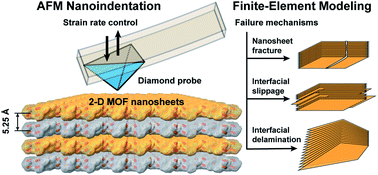Nanomechanical behavior and interfacial deformation beyond the elastic limit in 2D metal–organic framework nanosheets†
Abstract
Nanoscale mechanical property measurements of nanoporous nanosheets face many challenges. Herein we show atomic force microscope (AFM)-based nanoindentation to probe the nanoscale mechanical properties of a 2-D metal–organic framework (MOF) nanosheet material containing atomic-sized pores, termed CuBDC [copper 1,4-benzenedicarboxylate]. The sample thickness ranged from ∼10 nm (tens of monolayers) up to ∼400 nm (a stack of multilayers). In terms of its elastic–plastic properties, the Young's modulus (E ∼ 23 GPa) and yield strength (σy ∼ 450 MPa) were determined in the through-thickness direction. Moreover, we characterized the failure mechanisms of the CuBDC nanosheets, where three failure mechanisms were identified: interfacial slippage, fracture of the framework, and delamination of multilayered nanosheets. Threshold forces and indentation depths corresponding to these failure modes were determined. To gain insights into the failure mechanisms, we employ finite-element models with cohesive elements to simulate the interfacial debonding of a stack of 2-D nanosheets during the indentation process. The nanomechanical AFM methodology elucidated here will pave the way for the study of other 2-D hybrid nanosheets and layered van der Waals solids.



 Please wait while we load your content...
Please wait while we load your content...